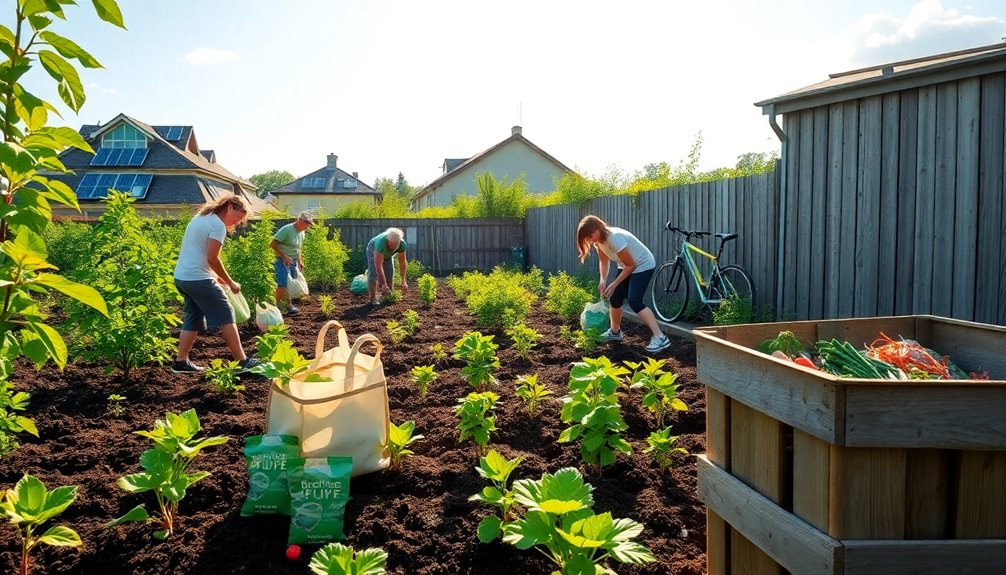To reduce your carbon footprint, start by choosing public transportation or carpooling whenever possible. Opt for biking or walking for short trips, and consider cutting down on air travel. Purchase energy-efficient appliances and educate yourself on sustainable practices. Don't forget to offset your carbon emissions and prioritize reducing, reusing, and repurposing items. Advocate for environmental policies in your community. There's a lot more you can do to make a difference, so keep exploring your options!
Key Takeaways
- Utilize public transportation, carpooling, or ride-sharing to lower emissions and reduce traffic congestion.
- Switch to energy-efficient appliances and renewable energy sources to decrease energy consumption and carbon footprint.
- Adopt active transportation methods like biking or walking for short distances to promote health and sustainability.
- Reduce, reuse, and recycle to minimize waste and educate others on eco-friendly practices within your community.
- Make dietary changes by incorporating more plant-based meals and limiting meat and dairy intake to lower greenhouse gas emissions.
Choose Public Transportation

Choosing public transportation can significantly reduce your carbon footprint while making your commute more convenient.
When you opt for buses, trains, or trams, you're sharing the ride with many others, cutting down on the number of vehicles on the road. This shared space helps lower greenhouse gas emissions.
You'll also save on fuel costs and parking fees, freeing up your budget for other priorities. Plus, public transit often allows you to relax or catch up on reading instead of stressing over traffic.
Many cities offer apps to track schedules and routes, making it easier than ever to plan your journey.
Carpool or Ride-Share

Carpooling or using ride-share services is another effective way to cut down your carbon footprint while enjoying the benefits of shared travel.
By sharing rides with others, you reduce the number of vehicles on the road, which lowers greenhouse gas emissions and traffic congestion. Plus, it can save you money on fuel and parking costs.
To make it easier, consider joining local carpool groups or using ride-share apps that connect you with others heading in the same direction. Not only does this help the environment, but it also fosters community connections.
Remember to coordinate schedules and establish clear meeting points to ensure a smooth experience. Embrace carpooling or ride-sharing, and you'll contribute to a greener planet while enjoying the journey.
Opt for Biking or Walking

One of the simplest ways to reduce your carbon footprint is by opting for biking or walking whenever possible. Not only do these modes of transport produce zero emissions, but they also promote a healthier lifestyle.
Imagine enjoying the fresh air and staying active while running errands or commuting to work. Biking and walking can save you money on gas and parking, too. Plus, they allow you to connect with your community in a meaningful way.
Enjoy the fresh air, save money, and connect with your community by biking or walking for errands and commutes.
If your destination is within a few miles, grab your bike or lace up your walking shoes instead of hopping in the car. You'll be amazed at how much you can accomplish without relying on fossil fuels.
Make the switch today and feel the difference!
Reduce Air Travel

While biking and walking are excellent ways to cut down on emissions for short trips, longer journeys often require air travel, which significantly increases your carbon footprint.
To reduce this impact, consider alternatives like trains or buses for your travel. If flying is unavoidable, try to book direct flights, as takeoffs and landings emit the most carbon.
You can also offset your emissions by investing in carbon offset programs that support renewable energy projects. Additionally, plan your trips wisely; consolidating travel dates can help minimize flights.
Lastly, when possible, explore virtual meetings or vacations. By making these choices, you'll not only help the planet but also inspire others to think twice about their travel habits.
Purchase Energy-Efficient Appliances

Have you ever considered how much energy your home appliances consume? By choosing energy-efficient appliances, you can significantly cut down your energy use and lower your carbon footprint.
Look for the ENERGY STAR label when you shop; it indicates that the appliance meets strict energy efficiency guidelines. Whether you're buying a refrigerator, washing machine, or dishwasher, these appliances use less electricity and water, saving you money in the long run.
Additionally, they often perform better, providing you with more effective results. When it's time to replace an old appliance, prioritize energy efficiency.
You'll not only contribute to environmental sustainability but also enjoy the benefits of reduced utility bills and a more eco-friendly home.
Switch to Renewable Energy Sources

After upgrading your appliances to energy-efficient models, consider taking your commitment to sustainability a step further by switching to renewable energy sources.
You can choose solar, wind, or hydroelectric energy, which significantly reduce your carbon emissions. If installing solar panels isn't feasible, look into community solar programs or choose a green energy plan from your utility provider.
These options allow you to support renewable energy without major changes at home. You'll not only lower your carbon footprint but also often save money in the long run.
Plus, you'll contribute to a cleaner environment for future generations. Switching to renewable energy sources is a powerful way to make a lasting impact on the planet.
Reduce Water Consumption

Reducing water consumption is crucial not only for conserving this precious resource but also for lowering your carbon footprint.
Start by fixing leaks in your home; even a small drip can waste gallons over time. When you shower, keep it short and consider installing a low-flow showerhead.
In the kitchen, only run your dishwasher when it's full, and opt for a basin wash instead of running water for dishes.
Water your plants early in the morning or late in the evening to minimize evaporation. Additionally, collect rainwater for gardening purposes.
Practice Mindful Eating

While many people focus on what they eat, practicing mindful eating also involves how you eat, which can significantly impact your carbon footprint.
Start by slowing down and savoring each bite. This not only enhances your dining experience but helps you appreciate your food, reducing the likelihood of overeating.
Slow down and savor each bite to enhance your dining experience and appreciate your food more fully.
When you eat mindfully, you're more inclined to choose foods that are nutritious and less processed, which often have a lower environmental impact.
Aim to minimize food waste by serving smaller portions and only going for seconds if you're still hungry.
Being present during meals allows you to make conscious choices, fostering a deeper connection with your food and its origins, ultimately leading to a more sustainable lifestyle.
Support Local and Sustainable Brands

Supporting local and sustainable brands not only boosts your community's economy but also significantly lowers your carbon footprint. When you choose products made nearby, you reduce the environmental impact associated with transportation.
Local businesses often prioritize sustainable practices, using eco-friendly materials and methods that minimize waste. By supporting these brands, you're encouraging ethical production and fostering a culture of sustainability in your area.
Take a moment to explore farmers' markets, craft fairs, or local shops that showcase sustainable goods. You'll likely find fresher, healthier options that align with your values.
Plus, connecting with local artisans and producers can lead to a more vibrant community. So next time you shop, consider how your choices can support both your community and the planet.
Minimize Single-Use Plastics

To make a real difference in your carbon footprint, it's essential to minimize single-use plastics in your daily life.
Start by substituting plastic bags with reusable ones when shopping. Ditch plastic water bottles and invest in a durable, refillable bottle instead. When dining out, say no to plastic straws and opt for reusable or biodegradable options.
Choose products with minimal or no plastic packaging, and focus on bulk items that reduce waste. Whenever possible, bring your own containers for takeout meals.
Recycle and Compost

After reducing single-use plastics, focusing on recycling and composting can further enhance your efforts to lower your carbon footprint.
Start by sorting your waste—create designated bins for recyclables like paper, glass, and metals. Make sure to rinse containers before tossing them in the recycling bin to avoid contamination.
Composting is another great way to reduce waste. You can compost kitchen scraps like fruit peels, vegetable trimmings, and coffee grounds.
Not only does this divert waste from landfills, but it also enriches your garden soil.
Use Eco-Friendly Products

While many products promise convenience, choosing eco-friendly alternatives can significantly reduce your carbon footprint.
Start by swapping out your cleaning supplies for biodegradable options. Look for products that are free from harmful chemicals and come in recyclable packaging.
Swap your cleaning supplies for biodegradable options to create a safer home and protect the planet.
When shopping for personal care items, opt for brands that prioritize sustainability and use natural ingredients. You can also choose reusable items, like cloth bags or stainless-steel water bottles, to cut down on single-use plastics.
Additionally, support companies that are committed to eco-friendly practices, as your purchasing power can drive change.
By making these simple switches, you'll contribute to a healthier planet while enjoying products that are safer for you and your family.
Make the change today!
Plant Trees and Support Green Spaces

Planting trees and supporting green spaces is a powerful way to combat climate change and enhance your local environment. Trees absorb carbon dioxide, improve air quality, and provide essential habitats for wildlife.
You can start by planting native trees in your backyard or participating in community tree-planting events. Local parks and community gardens also need your support; volunteer your time or donate resources to help maintain these vital spaces.
Creating green areas in urban settings can reduce heat and improve overall well-being. Don't forget to advocate for policies that protect existing green spaces and promote sustainable development.
Maintain Your Vehicle

Keeping your vehicle well-maintained is crucial for reducing your carbon footprint. Regular oil changes, tire rotations, and air filter replacements ensure your engine runs efficiently, which can significantly lower emissions.
Check your tire pressure monthly; under-inflated tires can decrease fuel efficiency. Also, keep an eye on your vehicle's alignment and brakes, as misalignments can cause unnecessary wear and tear, leading to higher fuel consumption.
If you notice any unusual sounds or warning lights, address them promptly to prevent further issues.
Finally, consider reducing your vehicle's weight by removing unnecessary items. By taking these simple steps, you'll not only improve your vehicle's performance but also contribute to a healthier planet.
Make maintenance a priority—your car and the environment will thank you!
Limit Meat and Dairy Intake

As you consider ways to reduce your carbon footprint, limiting your meat and dairy intake can make a significant impact. The production of these foods contributes heavily to greenhouse gas emissions, deforestation, and water usage.
By cutting back, you're not only lowering your carbon footprint but also promoting better health. Start by incorporating more plant-based meals into your diet. Explore delicious options like lentils, beans, and whole grains.
Try substituting dairy with alternatives such as almond or oat milk. Even small changes, like having meat-free Mondays, can lead to substantial reductions in your environmental impact.
Buy in Bulk

After making smarter choices about your meat and dairy consumption, consider buying in bulk as another effective strategy to reduce your carbon footprint.
When you purchase larger quantities, you often cut down on packaging waste, which means less plastic and cardboard end up in landfills. Plus, buying in bulk can save you money, allowing you to invest in more sustainable products.
Look for bulk bins at your local grocery store for grains, nuts, and spices. You'll also reduce trips to the store, which saves fuel and time.
Explore bulk bins at your local grocery store for grains, nuts, and spices to save money and reduce your environmental impact.
Just make sure to store your bulk items properly to avoid spoilage. By choosing this method, you're not just saving money; you're actively contributing to a healthier planet.
Educate Yourself and Others

While understanding the impact of your choices is crucial, educating yourself and those around you amplifies your efforts to reduce your carbon footprint. Start by researching sustainable practices, renewable energy, and the consequences of climate change. The more you know, the better decisions you can make.
Share this knowledge with family, friends, and colleagues; discussions can inspire collective action. Consider hosting workshops or casual meet-ups to engage others in learning. You could also follow credible environmental organizations and share their resources on social media.
Offset Your Carbon Emissions

One effective way to take responsibility for your carbon emissions is to invest in carbon offset programs.
These programs allow you to compensate for your emissions by funding projects that reduce greenhouse gases, like reforestation or renewable energy initiatives. When you purchase offsets, you're supporting efforts that remove or prevent CO2 from entering the atmosphere.
Before investing, research various programs to ensure they're reputable and transparent about their impact.
Look for certifications from recognized organizations to guarantee your contribution makes a difference. You can also consider incorporating offsets for specific activities, like flying or driving, to balance out your carbon footprint.
Reduce, Reuse, and Repurpose

Reducing waste is crucial for minimizing your carbon footprint, and the principles of reducing, reusing, and repurposing can make a significant impact.
Start by cutting down on what you buy; choose only what you truly need. This reduces the demand for new products and conserves resources.
Cutting back on purchases helps conserve resources and reduces the demand for new products. Choose only what you truly need.
Next, think twice before tossing items away. You can often find new uses for things you'd normally discard. For instance, glass jars can become storage containers or planters.
Finally, consider repurposing materials creatively. Old furniture can be transformed with a fresh coat of paint or new hardware.
Advocate for Environmental Policies

Advocating for environmental policies is essential if you want to drive meaningful change in your community and beyond.
Start by educating yourself about local, national, and global issues affecting the environment. Reach out to your representatives and express your views on policies that prioritize sustainability.
Join local advocacy groups to amplify your voice and connect with like-minded individuals. Attend town hall meetings and discuss environmental concerns, encouraging others to do the same.
Utilize social media to raise awareness and share impactful information. Remember, every small action counts.
By actively participating in the political process, you can influence decision-makers to adopt policies that help reduce carbon emissions and protect our planet for future generations.
Your voice matters—use it!
Frequently Asked Questions
How Does My Carbon Footprint Compare to the Global Average?
Your carbon footprint varies based on your lifestyle choices, like energy consumption, transportation, and diet.
On average, a person's footprint is about 4 to 5 tons of CO2 per year. If you live in a developed country, your footprint might be higher due to increased energy use.
You can check online calculators to compare your numbers with the global average and see where you stand.
Understanding this helps you make informed choices for a greener future.
What Are the Long-Term Benefits of Reducing My Carbon Footprint?
Reducing your carbon footprint means embracing a cleaner future, enjoying healthier air, and fostering a sustainable environment.
You'll witness the beauty of nature thrive, experience lower energy bills, and contribute to a stable climate. Your actions inspire others, creating a ripple effect that amplifies the positive change.
Plus, as technology advances, your choices align with innovations that benefit everyone. Overall, the long-term benefits enrich your life and the planet's future.
Can Lifestyle Changes Significantly Impact Climate Change?
Absolutely, lifestyle changes can significantly impact climate change.
When you choose to walk, bike, or use public transport instead of driving, you reduce emissions. You also save energy by using energy-efficient appliances and minimizing water usage.
Every small action, like recycling or reducing meat consumption, adds up. By making conscious choices, you not only lower your carbon footprint, but you also inspire others to join in, creating a ripple effect for positive change.
How Can I Measure My Carbon Footprint Effectively?
To measure your carbon footprint effectively, start by tracking your daily activities.
Use online calculators that ask about your energy use, transportation habits, and waste production. Keep a record of your electricity bills, fuel consumption, and waste disposal.
You can also monitor your diet, as food choices impact your footprint. By compiling this data, you'll get a clearer picture of your emissions and identify areas for improvement in your lifestyle.
What Role Do Businesses Play in Reducing Carbon Footprints?
Businesses play a crucial role in reducing carbon footprints by adopting sustainable practices. They can implement energy-efficient technologies, minimize waste, and source materials responsibly.
By promoting eco-friendly products and practices, they influence consumer behavior, encouraging you to make greener choices. Moreover, many companies set emissions reduction targets, showcasing their commitment to sustainability.
When businesses prioritize environmental responsibility, they not only lower their own footprints but also inspire you and others to follow suit.
Conclusion
So, while you might think your little choices don't matter in the grand scheme of things, remember that every small effort adds up. By choosing public transport or biking instead of driving, you're not just saving the planet; you're also saving on gas money. Who knew being eco-friendly could come with perks? So, get out there, make those changes, and watch as your carbon footprint shrinks faster than your last New Year's resolution!









